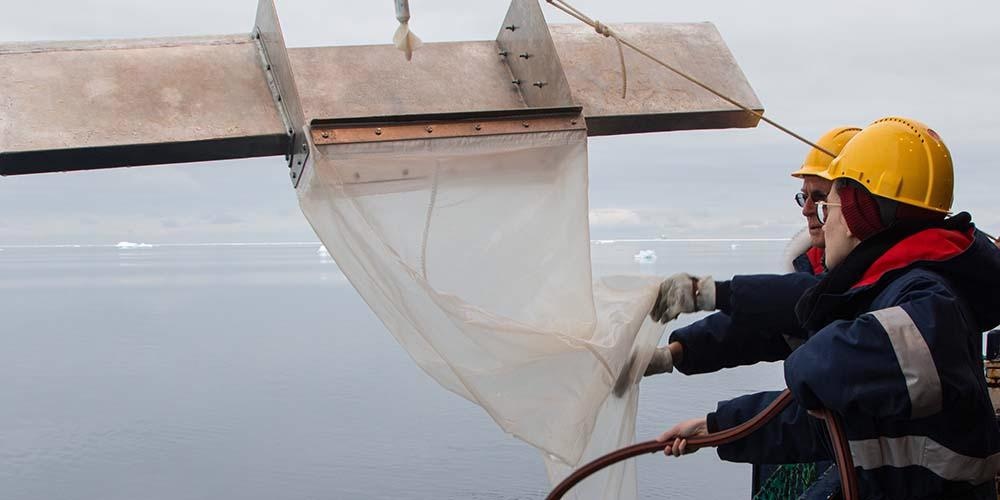Microplastics are all over the place, even in the most remote regions of the world. Where do these minute pieces of plastic originate from? Scientists from the University of Basel and the Alfred-Wegener Institute have demonstrated that it requires precise analysis to respond to this question.
 The plankton net used to sample the water surface is rinsed off before sampling to remove any particles that may have adhered beforehand. (Image Credit: University of Basel, Patricia Holm).
The plankton net used to sample the water surface is rinsed off before sampling to remove any particles that may have adhered beforehand. (Image Credit: University of Basel, Patricia Holm).
Microplastics are an environmental issue as organisms swallow these minute particles and can be injured by them. Even remote regions like Antarctica are impacted.
To measure this form of pollution and learn where the small particles originate from, a research group from the Department of Environmental Sciences at the University of Basel and the Alfred-Wegener Institute (AWI) at the Helmholtz Centre for Polar and Marine Research on the island of Heligoland examined water from the Weddell Sea, a region with least amount of human activity.
This is the first time a study of this scope has been conducted in Antarctica.
Clara Leistenschneider, Doctoral Candidate, Department of Environmental Sciences, University of Basel
During the course of two expeditions with the research vessel Polarstern in 2018 and 2019, the scientists collected a total of 34 surface water samples and 79 subsurface water samples. They sifted about eight million liters of seawater in total and found microplastics in it — although in minute quantities. The team has reported their findings in the journal Environmental Sciences and Technology.
Previous studies of microplastics in Antarctica were carried out in areas with more shipping traffic, research stations and people.
The study team, headed by Professor Patricia Holm (University of Basel) and Dr. Gunnar Gerdts (AWI), thus theorized that the remote Weddell Sea would have considerably lower concentrations of microplastics. However, their measurements revealed that concentrations are only somewhat lower than in other regions of Antarctica.
Paint and Varnish Are Probably the Main Sources
Proving that microplastics exist in a particular region is one thing.
But it's also important to know which plastics appear, in order to identify their possible origin and in the best case to reduce microplastic emissions from these sources.
Clara Leistenschneider, Doctoral Candidate, Department of Environmental Sciences, University of Basel
The scientists first examined the plastic composition of the particles sieved out of the seawater. They discovered that 47% of the particles distinguished as microplastics were composed of plastics that can be used as a binding agent in marine paint. That means marine paint and thus shipping traffic are apparently the main source of microplastics in the Southern Ocean.
Other microplastic particles were recognized as polypropylene, polyethylene and polyamides. These are used in fishing nets and packaging materials, among other things. Leistenschneider counsels that although it is possible to establish the various plastics used, the precise origin or earlier application of the microplastic fragments is not identified.
Additional Analysis Uncovers New Findings
In this research, over half of all sample fragments had visual elements resembling the paint on the research vessel Polarstern on which the researchers were traveling.
At the Center for Marine Environmental Sciences (Marum) at the University of Bremen, the team examined these fragments closely by means of X-ray fluorescence (XRF) to detect pigments and fillers, as the frequently used method — Fourier transform infrared microscopy (FT-IR) — did not detect these materials.
Together with binding agents, they are a key component of paint and are examined in forensics, along with their plastic content, to detect, for example, cars in hit-and-run accidents. Paint slivers left at the accident site are, as it were, the fingerprints of the vehicle.
The study in Bremen revealed that 89% of the 101 microplastic particles analyzed closely did certainly originate from the Polarstern. The remaining 11% originated from other sources.
This finding made Leistenschneider comment: “A number of comparative methods must be used to determine the origin of paint particles.” This is the only way to identify paint fragments found in the environment from contamination because of the research vessel.
Earlier microplastics studies generally omitted particles resembling the paint on their own research vessels (based on the components of binding agents and/or visual characteristics) as contamination without carrying out analysis.
Shipping traffic in the Southern Ocean has been growing in the last few years, mainly as a result of greater tourism and fishing, but also because of research expeditions.
Developing alternative marine paint that is more durable and environmentally friendly would make it possible to reduce this source of microplastics and the harmful substances they contain.
Clara Leistenschneider, Doctoral Candidate, Department of Environmental Sciences, University of Basel
Journal Reference:
Leistenschneider, C., et al. (2021) Microplastics in the Weddell Sea (Antarctica): A forensic approach for discrimination between environmental and vessel-induced microplastics. Environmental Sciences and Technology. doi.org/10.1021/acs.est.1c05207.